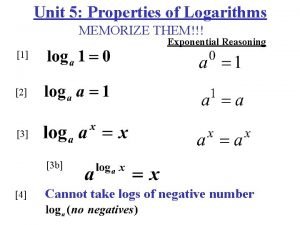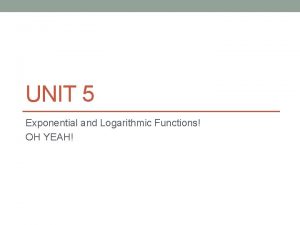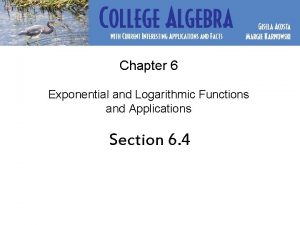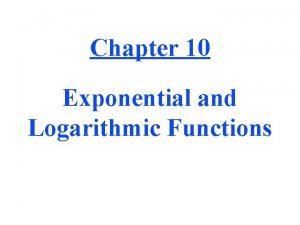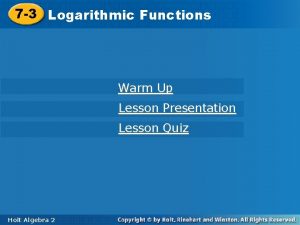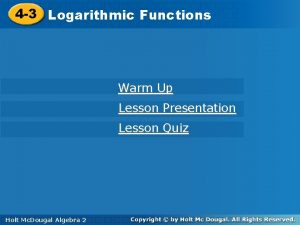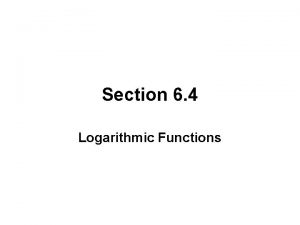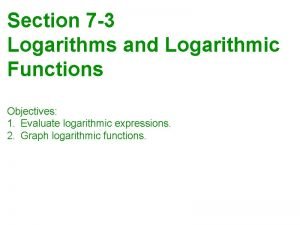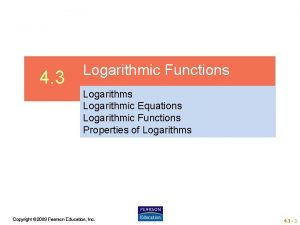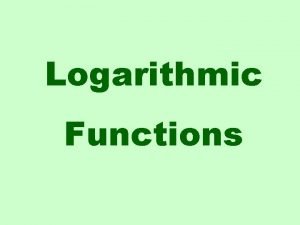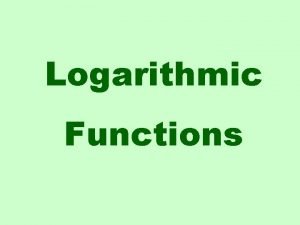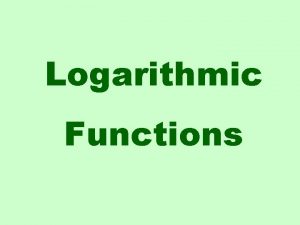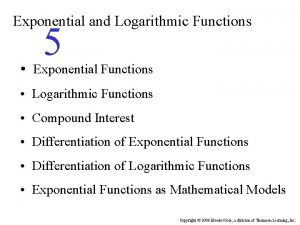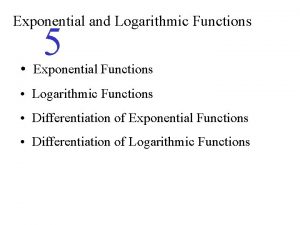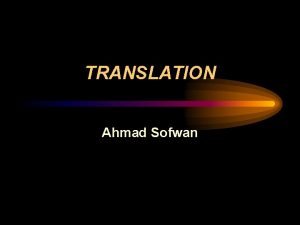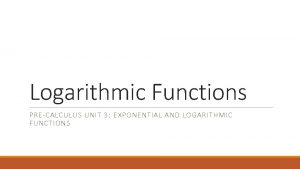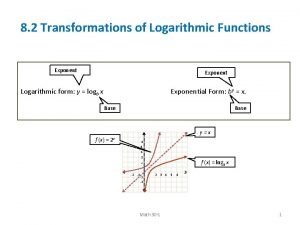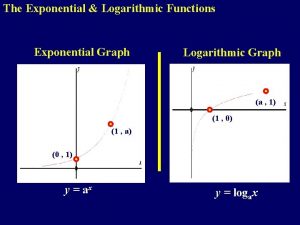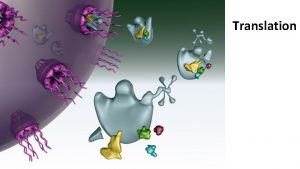Definition LOGARITHMIC FUNCTIONS of the logarithmic function Translation






















- Slides: 22

ØDefinition LOGARITHMIC FUNCTIONS of the logarithmic function. ØTranslation §from logarithmic functions to exponential functions. §from exponential functions to logarithmic functions. ØGraph of the logarithmic functions. CLICK HERE

Please use the buttons to move between screens PREVIOUS SLIDE NEXT SLIDE FIRST SLIDE LAST SLIDE RETURN

AT THE END OF THIS TUTORIAL YOU WILL BE ABLE TO Define the logarithmic functions as the inverse of t he exponential functions ü Change from logarithmic to exponential form. ü Change from exponential to logarithmic form. ü Graph the logarithmic functions based on the graph of exponential functions. ü Interpret graphs of functions of the form y=logbx and solve equations. ü Identify the equation of a given graph of a logarithmic function. ü

LOGARITHMIC FUNCTIONS (TABLE OF CONTENTS) � WHERE DID LOGARITHM COME FROM � INTRODUCTION � DEFINITION � GRAPH TO LOGARITHM OF LOGARITHMIC FUNCTIONS

TABLE OF CONTENTS WHERE DID LOGARITHM COME FROM � The invention of logs in the early 1600 s fueled the scientific revolution. Logs were are used by scientists for easy computation of large numbers. � The word logarithm comes from arithmos meaning number and logos meaning ratio.

INTRODUCTION TO LOGARITHM How many of one number do we multiply to get another number? Example: How many 2 s do we multiply to get 8? Answer: 2 × 2 = 8, so we needed to multiply 3 of the 2 s to get 8 So the logarithm is 3 TABLE OF CONTENTS

TABLE OF CONTENTS We would write "the number of 2 s you need to multiply to get 8 is 3” as log 2(8) = 3 !!! Notice we are dealing with three numbers: � The base: the number we are multiplying (a "2" in the example) � How many times to use it in a multiplication (3 times, which is the logarithm) � The number we want to get (an "8")

QUESTION: What is log 2(32). . . A 4 B 5 C 6 D 7 ? TABLE OF CONTENTS SOLUTION: We are asking "how many 2 s need to be multiplied together to get IF YOU GIVE WRONG ANSWER CLICK 32? " THE SOLUTION 2 ×HERE 2 ×TO 2 SEE × 2 = 32, so we need 5 of the 2 s Answer: log 2(32) = 5

DEFINITION OF LOGARITHMIC FUNCTION TABLE OF CONTENTS If b is any number such that b>0 and b≠ 1 and x>0 then, y=logbx is equivalent to bᵞ=x We usually read this as “log base b of x”. Ø In this definition y=logbx is called the logarithm form and bᵞ=x is called the exponential form.

TABLE OF CONTENTS !! ! Taking logarithms is the reverse of taking exponents, so you must have a good grasp on exponents(if you don’t click here) before you can hope to understand logarithms properly. Exponents and Logarithms are inverse functions.

Example 1: Evaluate log₄16. TABLE OF CONTENTS Okay what we are really asking here is the following. log₄16=? As suggested above, let’s convert this to exponential form. log₄16=? 4ˀ= 16 Most people cannot evaluate the logarithm log₄16 right off the top of their head. However, most people can determine the exponent that we need on 4 to get 16 once we do the exponentiation. So, since, 4²=16 we must have the following value of the logarithm. log₄16=2

Example 2: Evaluate log₅1/125 TABLE OF CONTENTS Now, this one looks different from the previous parts, but it really isn’t any different. As always let’s first convert to exponential form. log₅1/125 =? 5ˀ=1/125 First, notice that the only way that we can raise an integer to an integer power and get a fraction as an answer is for the exponent to be negative. So, we know that the exponent has to be negative. Now, let’s ignore the fraction for a second ask 5ˀ=1/125 . In this case if we cube 5 we will get 125. So, it looks like we have the following, log₅1/125=-3 because 5ˉ³= 1/5³=1/125

QUESTION: What is x in log 3(x) =5? A 75 B 125 C 243 D 625 TABLE OF CONTENTS Convert it to the exponential form HINT As always let’s first convert to exponential form. ANSWER log 3(x) IF YOU GIVE WRONG = 5 HERE TO SEE 3⁵=X CLICK THE SOLUTION Then X=243

QUESTION: What is y in y=log 4(1/4) A TABLE OF CONTENTS -1 Start with y=log 4(1/4) B 0 C 1 D 2 IF YOU GIVE 4 Ay = WRONG ANSWER ¼ CLICK HERE TO SEE THE 1/4 = 4 -1 SOLUTION 4 y = 4 -1 y = -1

TABLE OF CONTENTS GRAPH OF LOGARITHMIC FUNCTIONS Remembering that logarithms are the inverses of exponentials, this shape for the log graph makes perfect sense: the graph of the log, being the inverse of the exponential, would just be the "flip" of the graph of the exponential. To sketch the graph of y = logₐx, you can use the fact that the graphs of inverse functions are reflections of each other in the line y = x.

TABLE OF CONTENTS Let’s look at the graph of f(x) = 2ᵡ and g(x)=log₂x For f (x) = 2ᵡ , construct a table of values. x -2 -1 0 1 2 3 F(x)=2ᵡ 1/4 1/2 1 2 4 8 By plotting these points and connecting them with a smooth curve, you obtain the graph shown in Figure 1. 1

TABLE OF CONTENTS Because g(x)=log₂x is the inverse function of f(x)=2ᵡ , the graph of g is obtained by plotting the points (f(x), x) and connecting them with a smooth curve. The graph of g is a reflection of the graph of f in the line y = x, as shown in Figure 1. 2

TABLE OF CONTENTS The basic characteristics of logarithmic graphs are summarized in Figure 1. 3 § § § § Graph of y = logₐx, a>1 Domain: (0, ∞ ) Range: ( -∞, ∞ ) x-intercept: (1, 0) Increasing One-to-one, therefore has an inverse function Reflection of graph of y = a x about the line y = x. Figure 1. 3

TABLE OF CONTENTS ! !! You can use the link below to plot the graph of logarithmic and exponential functions and easily see that the graphs are reflections of each other in the line y = x. http: //graphsketch. com/

QUESTION: What is the equation of graph shown in Figure 1. 4 A f(x)=log₅x B f(x)=log 10 x C f(x)=log₂x D f(x)=log₄x Figure 1. 4 ! !! IF YOU GIVE A WRONG ANSWER CLICK HERE TO SEE THE SOLUTION TABLE OF CONTENTS

SUMMARY TABLE OF CONTENTS � If b is any number such that b>0 and b≠ 1 and x>0 then, y=logbx is equivalent to bᵞ=x We usually read this as “log base b of x”. � Exponents � To and Logarithms are inverse functions. sketch the graph of y = logₐx, you can use the fact that the graphs of inverse functions are reflections of each other in the line y = x.

REFERENCES � � TABLE OF CONTENTS http: //www. mathsisfun. com/algebra/exponentslogarithms. html http: //sydney. edu. au/stuserv/documents/maths_learning_ce ntre/intro_exp_logs. pdf http: //tutorial. math. lamar. edu/Classes/Alg/Log. Functions. asp x#Exp. Log_Ex 1 http: //ttkb. meb. gov. tr/program 2. aspx
 Log function definition
Log function definition Unit 8 review logarithms
Unit 8 review logarithms 7-5 properties of logarithms
7-5 properties of logarithms Examples of exponential equations
Examples of exponential equations Log function
Log function Linear quadratic exponential absolute value
Linear quadratic exponential absolute value Chapter 6 exponential and logarithmic functions answers
Chapter 6 exponential and logarithmic functions answers Chapter 4 exponential and logarithmic functions
Chapter 4 exponential and logarithmic functions Chapter 4 exponential and logarithmic functions
Chapter 4 exponential and logarithmic functions Solving exponential and logarithmic equations worksheet
Solving exponential and logarithmic equations worksheet Chapter 10 exponential and logarithmic functions answers
Chapter 10 exponential and logarithmic functions answers Property of equality for exponential functions
Property of equality for exponential functions 7-3 logarithms and logarithmic functions answers
7-3 logarithms and logarithmic functions answers Integration of exponential
Integration of exponential 4-3 logarithmic functions answers
4-3 logarithmic functions answers Transforming exponential and logarithmic functions
Transforming exponential and logarithmic functions Composite exponential function
Composite exponential function Chapter 5 exponential and logarithmic functions
Chapter 5 exponential and logarithmic functions Logarithims
Logarithims Chapter 9 exponential and logarithmic functions answer key
Chapter 9 exponential and logarithmic functions answer key Chapter 9 exponential and logarithmic functions answer key
Chapter 9 exponential and logarithmic functions answer key Chapter 5 exponential and logarithmic functions answer key
Chapter 5 exponential and logarithmic functions answer key Vertical stretch
Vertical stretch


